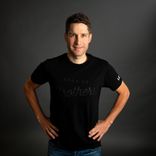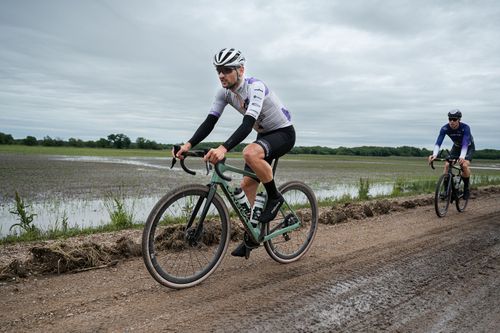As a former World Tour professional cyclist, Paul Voß has taken part in numerous Grand Tours - for some time now, he has been a successful gravel bike professional and cross rider.
Together with nutrition expert Robert Gorgos, he provides insights into how to optimally prepare for a gravel bike race and how to eat well during the race.
It already depends on the right training
Paul has been competing in top-level cycling for a long time and therefore has a very good basic endurance.
In order to prepare himself for the challenge of gravel races, which was new to him at the beginning, he has set certain stimuli through specific training.
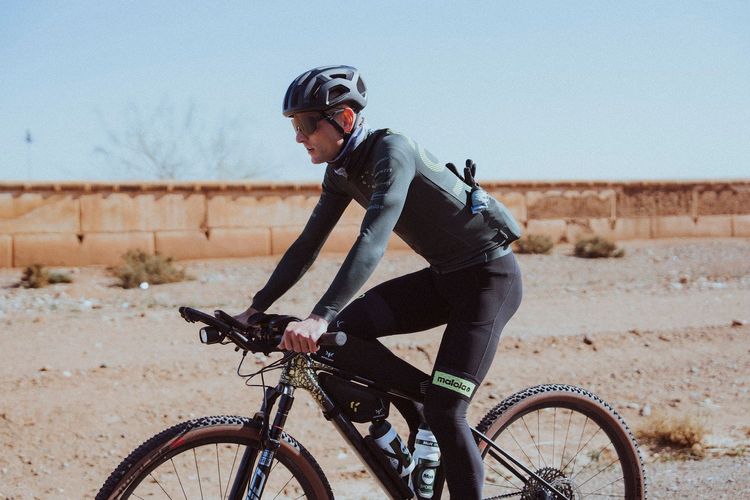
VO2max, or: How big is the engine of an endurance athlete?
The maximum oxygen consumption (VO2max) is one of the most important parameters for the endurance performance of a top athlete and thus also for Paul's training.
On the one hand, it is partly influenced organically (lung volume) and genetically, but it can also be trained to a large extent.
VO2max indicates the aerobic capacity of an athlete. Simplified, in training science it is also referred to as the "engine size".
VLamax, or: How efficient is the engine of an endurance athlete?
In contrast, if you look at anaerobic performance, the lactate production rate VLamax plays the central role. This value describes the ability to generate a maximum amount of energy through the metabolisation of carbohydrates - and this in an anaerobic state, i.e. without oxygen supply.
Here, too, training science has chosen a somewhat easier-to-understand term and speaks of "motor efficiency".
The VLamax therefore determines how quickly the endurance power is available and how high the carbohydrate consumption ("fuel consumption") is.
However, one thing must be taken into account: If you have a high value, this does not mean that you are more efficient.
The distance to be covered and the intensity of the respective sport place different demands on the VLamax.
A sprinter, for example, would have a significantly higher value because he produces more lactate per second. Unlike a long-distance runner, however, he cannot maintain a steady pace for as long.
It is of great importance in gravel races to burn as few carbohydrates as possible - and still ride close to the performance limit. For this reason, a low lactate build-up rate is advantageous.
**The higher the VLamax, the more carbohydrates are consumed. And because our carbohydrate stores are limited, this plays a big role. **
Let's get back to Paul: He has found out with tests that he has between 350 and 400g of carbohydrates available in his storage while cycling.
**The problem with this is that this amount would never be enough to compete in a long gravel race. In addition, it is not possible to supply the body with an unlimited amount of carbohydrates from the outside all the time. That's why it's crucial to use your energy efficiently and by burning fats.
And that's exactly why threshold training is so important.

Threshold training leads to better energy supply.
This type of training gets its name from the fact that it takes place at the limit of the anaerobic threshold. This is the area where your body switches from aerobic to anaerobic energy production.
At this threshold, lactate is broken down as quickly as it is formed (lactate steady state). Training at this point is very effective for endurance athletes. This optimises their energy supply because they use fewer carbohydrates and more fats for energy production.
As a result, performance can be maintained for longer because even more carbohydrates are available for energy production.
Paul's threshold training, for example, looks like this: He is on the bike for a total of 4 hours, building in intervals of 4x20 minutes around 340 to 360 watts. Because he consumes a lot of carbohydrates in this range, this type of training is a good way to train his carbohydrate intake.
He consumes 573 to 634g of carbohydrates and 139 to 166g of fat. During the training, he wanted to test whether he could consume 120g of carbohydrates per hour.
For this purpose, Paul used RACE CARB X from MNSTRY, which he divided into two bottles and diluted it with water. He also stopped every now and then to add some water to the bottles.
RACE CARB X is a special carbohydrate drink that Robert Gorgos (nutritionist at BORA-hansgrohe, among others) developed especially for long-term endurance competitions. The special mixture of different carbohydrate sources (rice syrup, fructose, tapioca starch) makes it possible to take in up to 120g of carbohydrates per hour - with optimal tolerance.
A practical example of threshold training
To get the most out of your threshold training, you have a number of options. For example, there are threshold intervals with hard starts. This aims to maintain high intensities for a longer period of time and reduce muscular fatigue.
You could ride for about 90 minutes and include five intervals of nine minutes each. In the first 30 seconds of these intervals you ride at 130-140% of your functional threshold power. This is the maximum power in watts you can pedal for an hour.
For the remainder of the interval, i.e. eight and a half minutes, you pedal at 95% of your functional threshold power.
It is important to recover for five minutes between intervals.
As you have already seen from Paul's example, you consume a lot of carbohydrates during this type of training.
That's why these sessions are ideal for training the intake of carbohydrates. You need a lot of carbohydrates.
Under no circumstances should you attempt to consume this amount for the first time during a competition. By the time the race starts, you should have found and tested your optimal nutrition strategy.
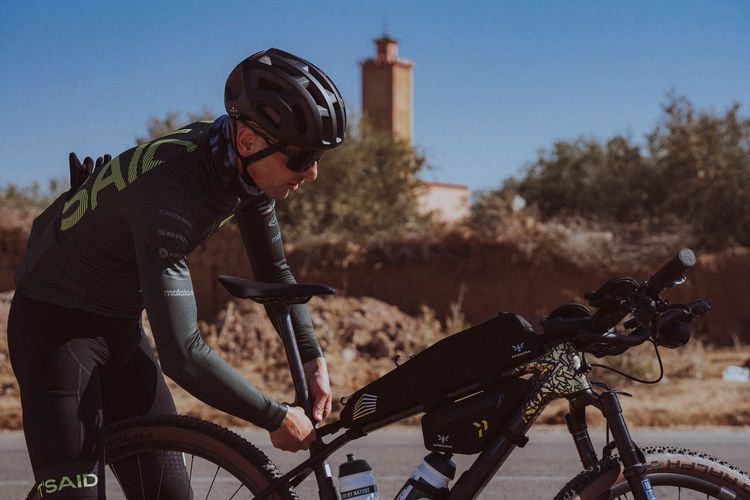
What is my personal nutrition strategy?
The maximum amount of carbohydrates you can take in and process varies greatly from person to person. That's exactly why it has to be tested beforehand. So the bigger your intake problems are, the more often you should train your carbohydrate intake.
If you can absorb carbohydrates well, for example, one or two such sessions per month will be enough. If you have problems, on the other hand, you should train once or twice a week. This is a good time to try out different products to find the best possible food for yourself.
For Paul, it has been shown that he tolerates a combination of POWER CARB, PORRIDGE BAR and GEL 40 best to get him through a race.
The POWER CARB provides energy through a special mixture of different carbohydrates that passes quickly into the blood - with optimal tolerance, which is what makes the products from MNSTRY special.
The GELs are also designed in such a way that you can take in 40g of carbohydrates per gel; and they weigh only 60g in total, which makes it easier to take the gels with you.
One of the reasons why the combination of different carbohydrates and also different products (e.g. POWER CARB and GELs) is so important is that we have two different transporters in the gut for carbohydrate absorption (GLUT-1 and GLUT-5).
GLUT-1 primarily absorbs glucose, but it cannot do this for infinite amounts. However, if another carbohydrate such as fructose is also taken in, GLUT-5 can be used as an additional transporter. In this way, an additional 60-70g of carbohydrates can be supplied, making a total of 120g possible per hour.
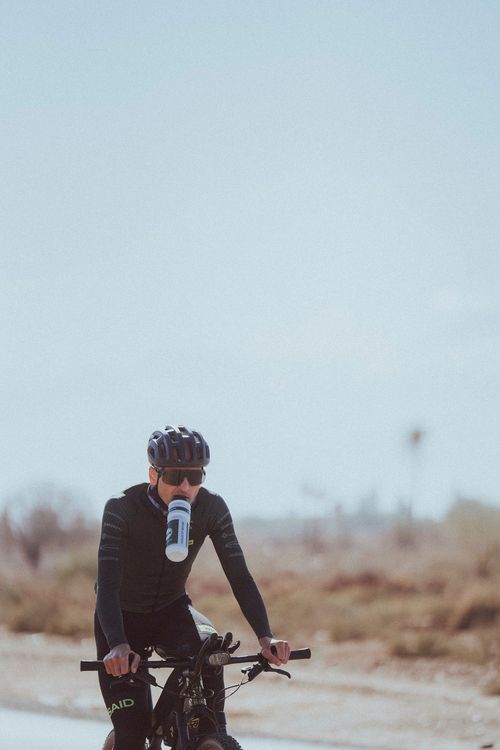
How to eat right before a gravel race
If you want to get the most out of yourself at the race, you should already take care of the right nutrition in the days before. You can try out every possible option.
Paul, for example, has worked his way up to the best possible diet step by step and developed a carbo-loading strategy.
He starts two days before the competition and tries to eat 8-10g of carbohydrates per kilogram of body weight. Only on the day before the competition does he eat as usual and reduce his carbohydrate intake.
If you want to learn more about carbo-loading and different loading strategies, you can read here: Carbo Loading so you best increase your performance in competition.
On the day of the competition, he also relies on a comparatively unspectacular diet. For breakfast he has a bowl of oatmeal with water and honey.
But because the Gravel races usually start early in the morning, there wouldn't be much time for digestion anyway - unless you want to get up extremely early.
But it is definitely more important here to start the race with a light and good feeling.
What matters during the race
The example of the Unbound Gravel
So, going into the race with only a light breakfast, Paul starts eating relatively early in the race itself. He aims for a carbohydrate intake of 90 to 100g per hour and starts this 20 minutes after the start.
Initially, he mainly uses PORRIDGE BARs, Carbohydrate Gums and POWER CARB. After three hours, he then feeds exclusively liquid food and GELs.
The PORRIDGE BARs are a good solid food source on the bike. They are based on complex carbohydrates and vegetable proteins that provide long-term energy.
If you take a closer look at an Unbound race, you will quickly see how high the carbohydrate consumption is - and how important the right food is accordingly.
During a race lasting about ten hours, more than 1500g of carbohydrates are consumed. Such extremely high values can hardly be found anywhere else.
Paul also used PORRIDGE BARs, POWER CARB and GELs in this race. But despite all the preparation and supposedly ideal nutrition, Paul temporarily collapsed after about four hours because he had been going a bit too fast until then.
In these phases, it is particularly difficult to eat the right food. Nevertheless, it is important to continue to consume 90 to 100g of carbohydrates per hour.
Because once you stop taking them in, there is no chance of recovery.
It was only through consistent and constant food intake that Paul managed to finish in slightly better shape again.
The right nutrition after the Gravel race
Now, of course, the carbohydrate stores have to be filled up again. For example, the RECOVERY SHAKE is suitable for this.
It combines carbohydrates, proteins and added amino acids, which makes it the perfect snack after a hard race. To increase the amount of carbohydrates, you can mix in some fruit such as bananas.
After such hard exertions as gravel races, it is recommended to drink another RECOVERY 8 some time after the RECOVERY SHAKE. This contains all eight essential amino acids and helps your muscles to regenerate particularly quickly. So that you don't completely sag after the race - and can quickly get back on your bike 😉
You want to try Paul Voss' sports nutrition from MNSTRY? With the code GRAVGRAV20 you get 20% discount on the MNSTRY sample box with free delivery (only for new customers, valid until 31.7.23).
Order now: on MNSTRY
